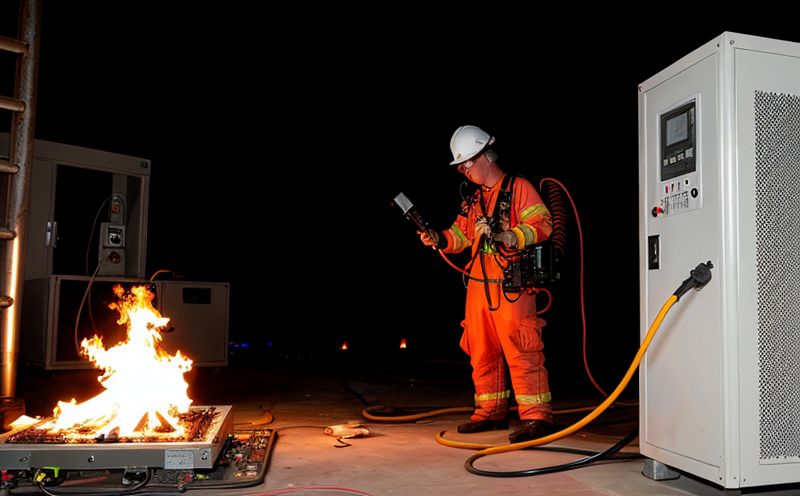Fire Resistance Testing of Switchgear
The fire resistance testing of switchgear is a critical process aimed at ensuring that electrical and electronic equipment meets safety standards in case of fires. This test evaluates the ability of switchgear to withstand exposure to flames or high temperatures without compromising its functionality, integrity, or causing ignition elsewhere. The focus is on preventing potential hazards such as electric arcs, which could exacerbate fire conditions.
Switchgear systems are essential components of electrical power distribution networks, and their failure during a fire can lead to catastrophic consequences. Therefore, understanding the specific requirements for testing these devices ensures that they meet both national and international standards, thereby protecting lives and property.
The test involves exposing switchgear specimens to controlled flame or heat sources according to specified ISO, ASTM, and IEC standards. The objective is not only to assess structural integrity but also to evaluate the performance of insulation materials, arc suppression capabilities, and the overall containment of any potential electrical arcing. Compliance with these standards guarantees that the equipment can be used safely in various industrial settings.
The process typically includes detailed preparation steps where the switchgear is assembled under controlled conditions before being subjected to rigorous testing procedures. This ensures accurate results reflecting real-world scenarios. Post-testing analysis involves thorough examination and documentation of any observed behaviors during exposure, including temperature rise rates, flame spread characteristics, and structural changes.
Accurate data collection throughout the test cycle provides valuable insights into how well different models perform under identical conditions, allowing manufacturers to improve designs iteratively based on empirical evidence. Regular updates to testing protocols ensure alignment with evolving industry practices and technological advancements.
In summary, fire resistance testing of switchgear plays a crucial role in enhancing safety measures within electrical infrastructure by identifying vulnerabilities early on through standardized evaluation methods. By adhering strictly to internationally recognized guidelines, organizations can demonstrate their commitment to maintaining high levels of safety and reliability across all operations involving such equipment.
Why Choose This Test
The decision to undergo fire resistance testing for switchgear is driven by several key factors that highlight its importance in safeguarding electrical installations against fires. First and foremost, compliance with relevant safety regulations and certifications is paramount; this ensures legal adherence while also enhancing reputation among stakeholders.
- Regulatory Compliance: Many jurisdictions mandate rigorous testing to ensure products meet stringent fire safety requirements. Non-compliance can result in product recalls or even legal action.
- Enhanced Safety: By demonstrating robust performance under extreme conditions, manufacturers reassure clients about the reliability of their offerings. This builds trust and loyalty among customers who rely on dependable solutions for critical applications.
- Innovation Opportunities: Engaging in advanced testing helps identify areas for improvement which can drive innovation within product development cycles. Continuous refinement leads to more efficient designs capable of withstanding harsh environments longer periods.
Achieving certification through reputable bodies like Underwriters Laboratories (UL), Intertek, or TÜV not only opens doors to broader markets but also signals commitment to quality assurance practices. These accolades instill confidence among buyers seeking reliable partners for long-term partnerships.
Moreover, investing in fire resistance testing demonstrates a proactive approach towards risk management strategies. It allows companies to anticipate potential issues before they escalate into larger problems requiring costly repairs or replacements. Early intervention minimizes downtime and associated costs while preserving operational efficiency.
In conclusion, opting for thorough fire resistance testing offers numerous benefits beyond mere compliance checks. It reflects an ongoing dedication to excellence in manufacturing processes, ultimately contributing towards creating safer environments for end-users worldwide.
Customer Impact and Satisfaction
The impact of conducting rigorous fire resistance tests on switchgear extends far beyond regulatory compliance; it significantly enhances customer satisfaction by addressing safety concerns head-on. When customers know their equipment has been rigorously tested, they feel assured that the product meets stringent quality standards.
- Peace of Mind: Knowing that a company takes proactive steps to ensure product reliability fosters trust between buyers and sellers. This leads to higher satisfaction levels among end-users who appreciate peace of mind knowing their investments are protected against unforeseen hazards.
- Better Decision-Making: Suppliers who provide detailed reports on testing outcomes give decision-makers valuable information when selecting components or systems for projects requiring high performance standards.
- Innovation Facilitation: Engaging in continuous improvement initiatives based on feedback from these tests encourages innovation within the organization. Customers appreciate suppliers who stay ahead of trends by incorporating new features into existing products.
By prioritizing safety, reliability, and longevity, manufacturers demonstrate their commitment to providing exceptional value to customers. This approach helps build lasting relationships built on mutual respect and understanding, ultimately leading to repeat business opportunities.
Furthermore, adhering to strict testing protocols showcases a supplier's dedication to excellence in every aspect of production. When combined with transparent communication about test results, it strengthens the bond between the supplier and its customers. Ultimately, this leads to increased customer loyalty and satisfaction, which are key drivers for sustained growth within competitive markets.





